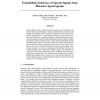Free Online Productivity Tools
i2Speak
i2Symbol
i2OCR
iTex2Img
iWeb2Print
iWeb2Shot
i2Type
iPdf2Split
iPdf2Merge
i2Bopomofo
i2Arabic
i2Style
i2Image
i2PDF
iLatex2Rtf
Sci2ools
NIPS
2003
2003
Probabilistic Inference of Speech Signals from Phaseless Spectrograms
Many techniques for complex speech processing such as denoising and deconvolution, time/frequency warping, multiple speaker separation, and multiple microphone analysis operate on sequences of short-time power spectra (spectrograms), a representation which is often well-suited to these tasks. However, a significant problem with algorithms that manipulate spectrograms is that the output spectrogram does not include a phase component, which is needed to create a time-domain signal that has good perceptual quality. Here we describe a generative model of time-domain speech signals and their spectrograms, and show how an efficient optimizer can be used to find the maximum a posteriori speech signal, given the spectrogram. In contrast to techniques that alternate between estimating the phase and a spectrally-consistent signal, our technique directly infers the speech signal, thus jointly optimizing the phase and a spectrally-consistent signal. We compare our technique with a standard met...
| Added | 31 Oct 2010 |
| Updated | 31 Oct 2010 |
| Type | Conference |
| Year | 2003 |
| Where | NIPS |
| Authors | Kannan Achan, Sam T. Roweis, Brendan J. Frey |
Comments (0)

